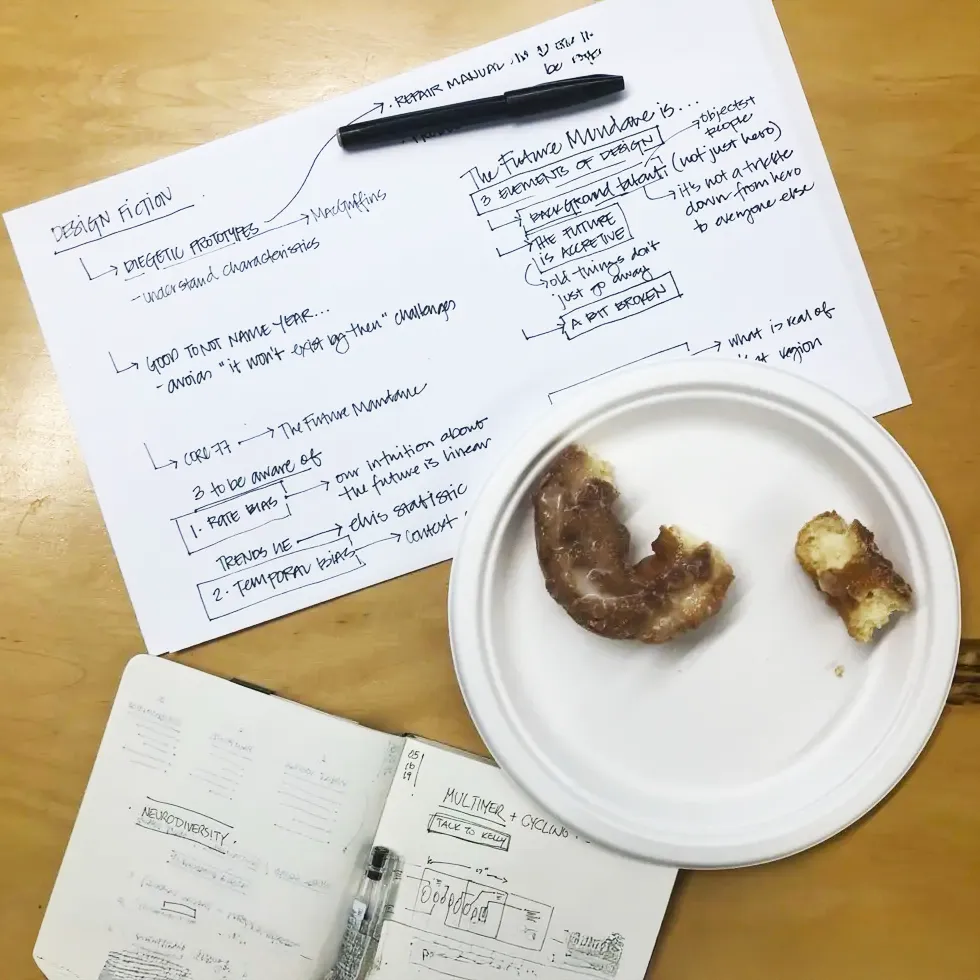
Came across this article on Medium by Marcelle van Beusekom, a thoughtful piece that’s a bit like a literature review of the Design Fiction close-cousin the ‘Future Mundane’. Marcelle’s piece is called Looking Back to Look Forward: Fiction, Friction and Future Mundane. In there she presents an approach to envisioning the future that stands in contrast to the often grand, distant, and utopian ideals found in conventional futurist narratives. Future Mundane is not your typical glossy CES future vision video. And it’s also not the dark cynical and frought representation of possible futures that comes from dystopian science-fiction, cyberpunk or likewise. In fact, ‘Future Mundane’ is precisely mundane in that it is notably unspectacular. It is about as exciting — and frought — as televisions we talk to or self-driving cars that get stuck in the middle of the road pondering what to do about some palm fronds that have blown on the street.
For van Beusekom, ‘Future Mundane’ is anchored visions of the future in the fabric of everyday life. van Beusekom emphasizes that meaningful future scenarios are those that reflect the ordinariness of human experience.
van Beusekom contends that future visions should be relatable and tangible to encourage real-world impact and inspire actionable insights. She presents five guiding principles to shape these grounded visions effectively, which I find super helpful if a bit didactic. But, hey — sometimes a good list is a good thing. Here they are:
1. Embrace Fiction and Friction
van Beusekom highlights the importance of storytelling in envisioning the future. Fiction is a tool for exploring potential scenarios, but it’s the “friction”—the challenges, conflicts, and imperfections—that make these narratives valuable. Friction embodies the complexities and obstacles that would naturally arise, offering deeper insights into what it might really take to bring future possibilities to life. Instead of avoiding these tensions, embracing them can reveal hidden aspects of innovation and design that simplistic utopian views might overlook.
2. Prioritize Human-Centered Design
Human-centered design is critical in ensuring that future visions remain connected to real needs and desires. Van Beusekom emphasizes that any successful future-oriented scenario must place people, with their emotions, habits, and complexities, at the center of consideration. This approach not only ensures that technologies and new ideas are relevant and useful but also helps foster trust and adoption by addressing genuine human concerns and aspirations.
3. Leverage Existing Narratives
The future is not created in isolation—it evolves from the stories, values, and traditions that have shaped the present. Van Beusekom encourages drawing from existing cultural narratives and collective experiences to guide future possibilities. By recognizing continuity between past, present, and future, we can craft scenarios that resonate more deeply with people’s lived experiences. This principle ties into the idea that innovation doesn’t have to start from scratch; it can emerge through the reinterpretation and evolution of familiar themes.
4. Focus on Key Objectives
Rather than being swept up by the multitude of “what-ifs” that come with futuristic thinking, van Beusekom advises focusing on a few critical “North Stars”—key objectives or driving goals. This focus helps maintain clarity and prevents visions from becoming overly diluted or unfocused. These North Stars can act as touchstones to guide decision-making and prioritize actions, ensuring that efforts are not scattered but aligned toward meaningful outcomes.
5. Learn from the Past
The past is a rich repository of knowledge, full of lessons that can inform how we move forward. Van Beusekom argues that by examining historical contexts, successes, and failures, we can better understand the trajectory of societal, technological, and cultural changes. This retrospection is not about clinging to outdated practices but about applying critical insights to navigate future uncertainties more effectively.
Integrating the Future Mundane
The “Future Mundane” is about balancing imagination with reality. It prompts us to envision not just high-tech, speculative possibilities but to consider how these developments integrate into the ordinary flow of daily life. A future that accounts for mundane routines, socio-cultural norms, and everyday interactions will be more relatable, implementable, and ultimately sustainable. By acknowledging that the future is an extension of the present and not an abrupt departure from it, we create scenarios that people can see themselves inhabiting.
van Beusekom’s approach pushes us to rethink how we frame the future—not as an unattainable or purely theoretical horizon, but as a continuation of our current journey, enriched by lessons learned and stories told. This shift encourages more practical, human-centered, and attainable visions of what lies ahead, making future-thinking a tool for genuine progress and transformation.
See Also